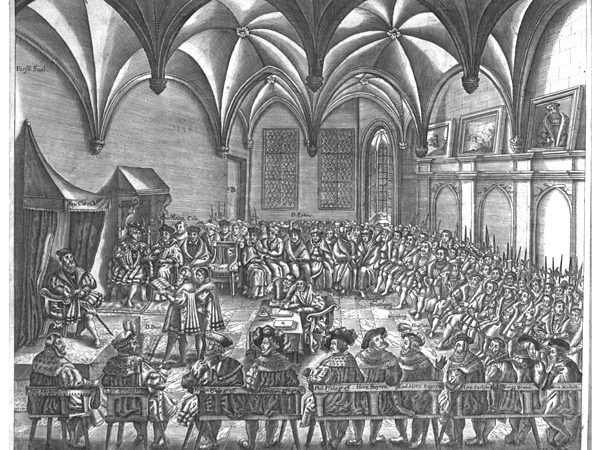As Roland Bainton writes in Reformation of the Sixteenth Century, “In the sixteenth century people did not commonly agree to differ.”[1] Political and religious disagreements often ended in violence. Remember Luther going into hiding at the Wartburg castle? It wasn’t because he was worried that his Scriptural interpretation would be questioned, or that there would be disagreements—it was a matter of safety. Luther would have otherwise been arrested and perhaps executed. Relations between Lutherans and Catholics were—understandably—rather rocky. And so the Peace of Augsburg was a welcome change to the instability and violence of the initial stages of Reformation within the Holy Roman Empire.

The Peace was an agreement between Emperor Charles V and the Schmalkaldic League,[2] and it established three main principles.[3] The first is the origin of the phrase cuius regio eius religio. Lutheran princes were allowed to declare Lutheranism as their state’s religion, and Catholic rulers could continue in their Roman ways. But “every one shall love the other with true friendship and Christian love.”[4] If someone was at odds with his ruler’s faith, he could lead himself out the city gates, along with his family. It was a peaceful separation, and a person moving would be guaranteed a fair price for the sale of his possessions. On this remarkable piece of legislation, Needham writes:
“The Peace of Augsburg…was a milestone in the history of religious toleration. It stipulated the territorial principle that a region was to follow the faith of its rule (prince, city council): a principle summed up in the Latin phrase cuius regio, eius religio (“whose region, his religion”). If anyone in a particular region disagreed with his ruler’s religion, he was allowed to move to a different region, with guaranteed rights to a fair sale of his property. In any city where both Lutherans and Roman Catholics were represented, each was to be tolerated. No prince or city council was permitted to offer any inducements to the inhabitants of other regions to change their faith.”[5]

The second principle—the ecclesiastical reservation—established the special status of the religious state (also referred to as the ecclesiastical state). It also stated that if a ruler of one of these states changed his religion, his subjects were not required to do the same.
The third was an addition by Ferdinand that exempted certain knights and cities from having to comply with this religious uniformity. These cities were exempt because they had maintained the same religion and peace for quite some time:
“In many free and Imperial cities, both religions—Our old religion and that of the Augsburg Confession—have for some time been practiced. They shall continue to exist and be maintained in these cities. The citizens and other residents of these free and Imperial cities, both of clerical and lay estates – shall continue to live peacefully and quietly with another.”[6]
This was momentous. To modern ears this freedom may not ring quite like the liberty bell, but we must remember that such tolerance is really quite modern. Bainton writes: “For the first time in the Christian West two confessions, the Roman Catholic and the Lutheran of the Augsburg Confession, were given equal legal recognition.” He goes on to say that “the Zwinglians, Calvinists, and Anabaptists were excluded,”[7] an assessment one can find repeated by most modern historians. In fact, however, there is no such explicit exclusion; rather, the Peace simply asserts that it extends to all who can subscribe to the Augsburg Confession. Most Calvinists were at this time willing to sign the 1540 “Variata” version of the Confession, and it was not until later, with the 1577 Formula of Concord, that this formally version was rejected by many Lutherans, creating an ambiguous situation for Calvinists within the Empire.
This is what would eventually bring this peace to an end in the following century, which would lead to a revised treaty with even more liberties in the Peace of Westphalia (the Reformed were then granted explicit legal recognition and protections). By no means was the Peace perfect or permanent, but “even so, for the next 60 years the Peace of Augsburg brought a degree of religious stability and freedom to Germany which it had not known since the heady days of 1517-21.” [8] [9]
Written by Josiah Roberts. Josiah is a graduate of New Saint Andrews College and serves as as Executive Assistant to the Presidentworks at the Davenant Institute. He lives in Moscow, ID with his wife Zoe.
Notes:
[1] Roland H. Bainton, The Reformation of the Sixteenth Century, Enl. ed. (Boston: Beacon Press, 1959), 142.
[2] The League was an alliance of Lutheran princes. They were the legal representation for all Protestants and were a reason why Lutheranism was recognized earlier on than Calvinists – they had an army.
[3] It was, however, negotiated by Ferdinand, Charles’ brother. Evident in the text of the peace “We, Ferdinand….” See http://germanhistorydocs.ghi-dc.org/sub_document.cfm?document_id=4386
[4] The Religious Peace of Augsburg (September 25, 1555), from http://germanhistorydocs.ghi-dc.org/sub_document.cfm?document_id=4386.
[5] Needham, 331.
[6] The Religious Peace of Augsburg (September 25, 1555), from http://germanhistorydocs.ghi-dc.org/sub_document.cfm?document_id=4386.
[7] Roland H. Bainton, The Reformation of the Sixteenth Century, Enl. ed. (Boston: Beacon Press, 1959), 155.
[8] N. R. Needham, 2,000 Years of Christ’s Power, Part Three: Renaissance and Reformation (averdale North Darlington: EP BOOKS, 2003), 331.
[9] Echoed in the Oxford Reference, “Although the agreement had many flaws and satisfied neither side completely it averted serious religious conflict within the empire for over 50 years.” See (http://www.oxfordreference.com/view/10.1093/oi/authority.20110803095434639).


One response to “September 25th: The Peace of Augsburg”
[…] principle of cuius regio eius religio as the solution to the religious conflict. According to the Davenant Institute, this Latin phrase meant that the religion of the ruler (Catholicism or Lutheranism) would be the […]